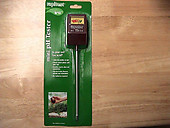A pH between 6.0 to 7.0 is a Good pH for worms. pH Over 7.0 or under 6.0 can be dangerous for composting worms like Red Worms, European Night Crawlers and other composting worms. The higher the pH the more alkaline the bedding is. The lower the pH the more acidic. It is best to have bedding that is right in the middle. 6.5 is the perfect pH.
The pH of your worm bed or composter should read approximately 7.0. The higher the pH the more alkaline your bedding is, and the lower the pH the more acidic it is. pH can be controlled in several ways. The easiest way is to have a bag of powdered limestone on hand. You can get this here on this site, or in a feed or garden store. Water the beds, but do not soak, sprinkle the limestone on the top of the bedding and let it absorb some water. Once the water is absorbed by the limestone you can mix it in. Mixing the limestone in dry can cause the worms to burn. You will notice that the worms will writhe around in pain and then will die if the dry limestone powder touches them. Once the powder is wet just mix it in and then check the pH. If it is still too acidic repeat the process. Another way to control acid is to turn the bedding weekly. The aeration process seems to decrease the acid thus increasing pH. Feeding products like egg shells will also help reduce the acid levels.?
Acid forms in the worm bed when too much grain or wheat based foods are fed to the worms. Try to use scraps of food that do not contain wheat or pulverized corn products. Too much wheat based or corn based products will sour the bedding and cause acid formation. High acid levels can also cause the formation of mites in the worm bed. A small population of mites is normal in worm beds, but a large population can indicate a high acid condition.



